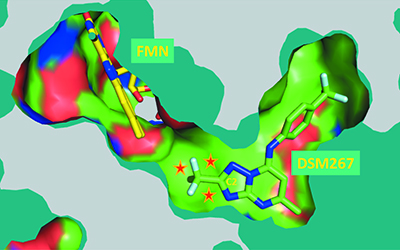3D structures in the design of therapeutics targeting parasitic protozoa
 Parasitic protozoa cause a range of diseases which threaten billions of human beings. They are responsible for tremendous mortality and morbidity in the least-developed areas of the world. In a special issue of Acta Crystallographica Section F: Structural Biology Communications dedicated to molecular parasitology Professor Wim G. J. Hol presents an overview of the evolution of structure-guided design of inhibitors, leads and drug candidates aiming at targets from parasitic protozoa [Hol, W. G. J. (2015). Acta Cryst. F71, 485-499; doi:10.1107/S2053230X15004987]. The article also contains a selection of examples where crystal structure determinations have assisted in the development of compounds which became promising drug candidates.
Parasitic protozoa cause a range of diseases which threaten billions of human beings. They are responsible for tremendous mortality and morbidity in the least-developed areas of the world. In a special issue of Acta Crystallographica Section F: Structural Biology Communications dedicated to molecular parasitology Professor Wim G. J. Hol presents an overview of the evolution of structure-guided design of inhibitors, leads and drug candidates aiming at targets from parasitic protozoa [Hol, W. G. J. (2015). Acta Cryst. F71, 485-499; doi:10.1107/S2053230X15004987]. The article also contains a selection of examples where crystal structure determinations have assisted in the development of compounds which became promising drug candidates.
The impact of parasites on human life has been and still is profound. Diseases caused by these protozoa occur most frequently in tropical areas, most intensively and tragically in the poorest populations. Underlying causes include poor water sanitation, intensive contact with intermediate vectors, lack of public health infrastructure and other factors.
A major concern is that the number of well tolerated therapeutics is very limited, or even absent, for essentially all of these parasitic diseases. The only exception is malaria, where a number of therapies have had some success.
A pioneering international effort to combat tropical maladies, including protozoan diseases, has been the creation of the UNICEF/UNDP/World Bank/WHO Special Programme for Research and Training in Tropical Diseases, abbreviated as TDR. This programme celebrated 40 years of existence in 2014. TDR with limited resources successfully managed to make the world more aware than ever before of a whole set of largely unrecognised tropical diseases. TDR was also able to leverage additional funds to promote research in this field.
Protozoan parasites have developed sophisticated mechanisms to circumvent human defense systems, which make the development of effective and affordable vaccines for the parasitic protozoa an enormous challenge. Therefore therapeutic compounds and in particular combinations of compounds, are likely to remain a cornerstone of antiparasitic strategies for a long time.
Structural information on drug targets can contribute to many stages of the long road leading to such compounds. Hence, it is encouraging that the number of three-dimensional structures of proteins from human parasites is approaching 2000. The challenge is to increase this body of knowledge and also to convert this three-dimensional information into compounds which prevent the diseases caused by these organisms. Three-dimensional structures can not only guide the design of compounds with great potency, but can also be of assistance in lead-optimization stages of drug discovery, when the selectivity, bioavailability, pharmacodynamics, pharmacokinetic, safety, formulation and other properties of the compound have to be improved.
The future requires increasing scientific and financial contributions from governmental, non-profit and for-profit institutions. While there is reason for considerable optimism for success in the coming years, formidable obstacles remain to be overcome before we are anywhere near the situation that was once the case in the field of antibiotics, where a broad arsenal of drugs was available. Even that arsensal is now hardly sufficient any more. This is a major lesson and emphasizes the need for the design of multiple new therapeutics for patients infected by parasitic protozoa.


